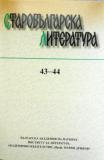Изображението на Св. Троица в наоса на църквата „Рождество Христово“ в Арбанаси – иконографски прототипи и съдържание
The Trinity Image in the Nave of the Nativity of Christ Church in Arbanassi: Iconographic Prototypes and Content
Author(s): Margarita KuyumdzhievaSubject(s): Fine Arts / Performing Arts
Published by: Институт за литература - БАН
Summary/Abstract: THE TRINITY IMAGE IN THE NAVE OF THE NATIVITY OF CHRIST CHURCH IN ARBANASSI: ICONOGRAPHIC PROTOTYPES AND CONTENT MARGARITA KUYUMDZHIEVA (SOFIA) (S u m m a r y) This composition belongs to the rare anthropomorphic type of Trinity imagery known in the relevant studies as Throne of Mercy, Gnadenstuhl, or Razpiatie v lone Otchem. It shows God the Father supporting close to His chest the crucified Christ and the Holy Spirit as a dove depicted above the cross. The Throne of Mercy is a variant of the Trinity which is emblematic for Western painting, where it already existed by the end of the 12th century. Its diffusion in Orthodox painting is very restricted both during the Byzantine and post-Byzantine periods. The Western composition influenced the images in the parish church of the Virgin in Roustica in Crete (1380-81) and in two Cypriot churches dedicated to the Holy Cross from the 15th and 16th centuries. The Throne of Mercy composition occurs also in Russian icon painting from the 16th-17th centuries, where it achieved a more radical transformation. Specific to the Russian variants are the depiction of Christ on the cross with cherub wings, and a crown on the head of God the Father. An elaborate image of this type is painted on the famous four-segment icon from the middle of the 16th century in the Annunciation Cathedral of the Moscow Kremlin. The 17th-century example of the Throne of Mercy in the Nativity of Christ church in Arbanassi strictly follows Russian variants, as known from the four-segment icon of the mural paintings in the Holy Dormition Monastery of Sviyazhsk (c. 1560), and from a similar 17th-century icon kept today in the Republic of Karelia Museum of Fine Arts. How the obviously direct Russian influence reached Arbanassi cannot be determined any more. Yet, it is well known that the Metropolitans of Tǎrnovo traditionally kept close ties with Russia, and that during the 16th and 17th centuries there were numerous visits of Bulgarian clergymen to Moscow. Often these visitors received church vessels and icons as presents. This fact may have furthered the transmission of this iconographic model to the Bulgarian church.
Journal: Старобългарска литература
- Issue Year: 2010
- Issue No: 43-44
- Page Range: 209-235
- Page Count: 27
- Language: Bulgarian
- Content File-PDF

